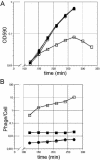Regulatory circuit design and evolution using phage lambda
- PMID: 15342489
- PMCID: PMC515287
- DOI: 10.1101/gad.1226004
Regulatory circuit design and evolution using phage lambda
Abstract
Bistable gene regulatory circuits can adopt more than one stable epigenetic state. To understand how natural circuits have this and other systems properties, several groups have designed regulatory circuits de novo. Here we describe an alternative approach. We have modified an existing bistable circuit, that of phage lambda. With this approach, we used powerful genetic selections to identify functional circuits and selected for variants with altered behavior. The lambda circuit involves two antagonistic repressors, CI and Cro. We replaced lambda Cro with a module that included Lac repressor and several lac operators. Using a combinatorial approach, we isolated variants with different types of regulatory behavior. Several resembled wild-type lambda--they could grow lytically, could form highly stable lysogens, and carried out prophage induction. Another variant could form stable lysogens in the presence of a ligand for Lac repressor but switched to the lytic state when the ligand was removed. Several isolates evolved toward a desired behavior under selective pressure. These results strongly support the idea that complex circuits can arise during the course of evolution by a combination of simpler regulatory modules. They also underscore the advantages of modifying a natural circuit as an approach to understanding circuit design, systems behavior, and circuit evolution.
Figures



References
-
- Alon U., Surette, M.G., Barkai, N., and Leibler, S. 1999. Robustness in bacterial chemotaxis. Nature 397: 168-171. - PubMed
-
- Atkinson M.R., Savageau, M.A., Myers, J.T., and Ninfa, A.J. 2003. Development of genetic circuitry exhibiting toggle switch or oscillatory behavior in Escherichia coli. Cell 113: 597-607. - PubMed
-
- Betz J.L., Sasmor, H.M., Buck, F., Insley, M.Y., and Caruthers, M.H. 1986. Base substitution mutants of the lac operator: In vivo and in vitro affinities for lac repressor. Gene 50: 123-132. - PubMed
-
- Calef E., Avitabile, L.d.G., Marchelli, C., Menna, T., Neubauer, Z., and Soller, A. 1971. The genetics of the anti-immune phenotype of defective λ lysogens. In The bacteriophage lambda (ed. A.D. Hershey), pp. 609-620. Cold Spring Harbor Laboratory, Cold Spring Harbor, NY.
-
- Carroll S.B. 2000. Endless forms: The evolution of gene regulation and morphological diversity. Cell 101: 577-580. - PubMed
Publication types
MeSH terms
Substances
Grants and funding
LinkOut - more resources
Full Text Sources
